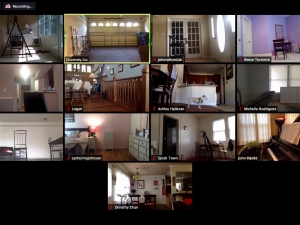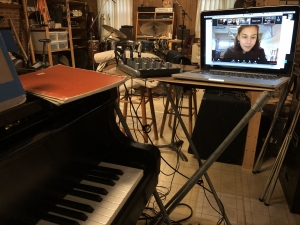Through the completion of the spring semester, students attended Courtney Liu’s Dance 121 "Advanced Beginning Ballet" every Monday and Wednesday without fail. They moved from their traditional, open dance studio at the Rubenstein Arts Center into modified personal spaces: pushing the dining room table and chairs against the wall or re-arranging the sofa and coffee table to yield a few more feet of space, setting up in the basement recreation room, moving to the bedroom, or sharing space with the family dog—but they showed up, ready to dance.
And Liu, a teaching assistant and MFA student in Dance, instructed them from her own reconfigured space: a one-car garage transformed into a dance studio complete with lights, a ballet barre, rubber padding on the floor, a desk, and a good pair of socks instead of ballet shoes.

Liu didn’t want anyone to feel shortchanged after the switch to remote learning. Over the extended Spring Break, she took a strategic look at the lesson plan, paying close attention to anything that could waste time. Warm-ups were modified to include a low-impact option for anyone dancing on hard floors, tape indicated where she could stand and still be in the students’ direct line of sight, quizzes were replaced with student-submitted videos of dance combinations, and marks on her desk indicated where to position the laptop so students had the best views of what she was demonstrating.
The major hurdle was the music—students needed synchronized music to set the tempo when they danced. How could she work with the audio time lags, a common issue in Zoom, without disrupting the flow of the class? She turned to the department’s music coordinator, John Hank, for help. Hanks had accompanied the class prior to remote learning, so he set up in his home music room, with a microphone and mixing board running into his laptop for the best sound quality, and started researching workarounds to solve the time lags. “Turning off the noise suppression devices helped, but it took a lot of tests to get it right.”
The elegant solution: Rather than the instructor setting the tempo, Hanks would. Back at the Ruby, Hanks would watch as Liu demonstrated a combination to the class, selecting a piece of music based on the tempo, movement quality, and what was typically appropriate for that particular ballet movement. With everyone in the same space, he was able to easily “read” cues and adjust accordingly.

Now from his home studio, he counted down the tempo to the class and played through the music without watching the students because everything he saw in the Zoom class
was delayed.
Prior to class, Liu and Hanks went over the lesson and worked out the tempos needed. In her remote studio, she demonstrated the move to the students, followed by Hanks counting down the tempo then playing the piano while Liu kept a close eye on the students’ screens—gently correcting form if needed and always providing encouraging feedback.
The new Zoom format brought some unplanned but pleasant surprises. Liu found the format was more conducive for teaching vocabulary. Her visual demonstrations from her souped-up studio, the ability to easily incorporate videos, and students soaking it all in through their personal screens made for more relaxed dancers. “In their final reflection papers, some seniors shared that Zoom has opened them to possibilities for dancing beyond graduation. They realized that even if they move to a new city or are traveling for work, they can still take online classes.” And the class successfully completed the syllabus – apart but also together.
As universities begin preparations for fall classes and face unfamiliar territory amid COVID-19, Hanks knows the arts will continue to be essential. In his 30-plus years of teaching, he’s always viewed arts courses as vital to the students. While visual and performing arts classes help students stay invested in a discipline that they’ve devoted years of practice to prior to coming to Duke, the arts also gives curious or novice students with little or no prior arts exposure the ways and means—and permission—to explore. “I’ve always felt that as arts instructors, we’re training the future doctor, lawyer, or investment banker to have an appreciation for the arts,” he explains.
“When you think of someone like David Rubenstein—yes, the donor and namesake of the Rubenstein Arts Center—he was one of those students who had his love of the arts raised to another level by his experiences at Duke. This work and teaching and learning will and must continue into the future—it’s essential.”
Note: Liu will teach the online Summer Session II course “Body Image and Gender” (Dance 290S-02) that focuses on ideologies of body image, eating, and exercise in dance, fashion, advertising, and athletics. In an increasingly image-based and digitized world, this course will present a space to reflect upon the current and future impact of COVID-19 on body image and embodied presence.